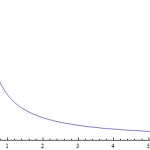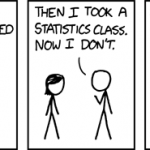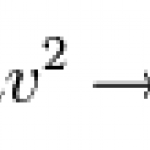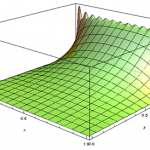
Whew! Busy week for me, hence the missing post or two. Traditionally Saturdays on this blog tend to be non-physics fare - either links, commentary on something nonscientific, or whatever. Today I think it will be the celebration of Pi Day!
Pi Day: As you know from the SB main page, today is pi day. 3/14, representing the famous number 3.14159265359...
You first meet is as the ratio of the circumference of a circle to its diameter. As you go on in math, you meet it pretty much everywhere else too. Seriously everywhere.
There's also a Pi Approximation Day, on 7/22. Which of course only…
A reader writes in with a question about the physics of Star Trek:
When the Enterprise goes into warp speed (which as I take it are multiples of the speed of light, warp 5, 5x the speed of light, etc.) and they show the ship zooming through the cosmos, they always show the stars its passing as elongated. In the special theory of relativity, is it not true that moving near the speed of light objects will appear to actually contract? But then again, according to relativity one can't go faster than the speed of light, so perhaps there is some other physical phenomena going on here. Or maybe I…
Conservative forces, that is!
Hold a basketball in your hand and move it around. When you move it up, you do work against gravity. You have to put energy into the system to get it to gain height. Relax your arm, and the force of gravity pulls it downward, converting that potential energy into kinetic energy and speeding up the ball's downward motion until you stop it with your hand.
You can wiggle the ball up, down, and all around. It doesn't matter what path the ball takes, if it starts and ends in the same place, the total energy transfer done by gravity is zero. Forces with this…
Imagine the scientists of the world got together and decided they didn't like the meter as a unit of distance. They were tired of traveling such long distances to conferences and decided that by redefining the new meters as two old meters, suddenly the plane flight was only 1000 kilometers instead of 2000 kilometers.
I don't think it's very plausible. Nonetheless, we do pretty much the same thing when we change back and forth between daylight savings time and standard time.
Now there are some good arguments for the change. It means kids don't have to stand in the dark waiting for their…
Let's start with a pretty simple function. It's not this week's official Sunday Function, but we'll use it to get there.
Take the number 1, divide it by x. Pretty easy. Now imagine putting a dot at the point x = 1 on the x axis, and draw a line straight up from there to the curve formed by the graph of the function. Then do the same thing for another point on the x axis (with x > 1). Shade in the area in between the lines. Ok, that might be a little hard to visualize if you've never done it before. Let me pick the other number to be x = 4, and I'll actually put the picture below…
As ScienceBlogs' resident firearms enthusiast (I might own more guns than the rest of the SB writers combined - and I don't own very many), I've occasionally written about gun rights and related issues. One of the things I've noticed is that a lot of people aren't very familiar with what gun laws actually are in the US. Here I'm going to take you on a tour of what's legal and what isn't in the US. I'll try to do so in a mostly neutral way, but for full disclosure I'd generally want to change the law in two directions - fewer restrictions on use, greater penalties for misuse. When my…
Via xkcd, an unusually clever comic even by the standards of this unusually clever comic:
It goes right to the heart of one of the greatest philosophical difficulties of science. All we can do is measure correlation. We can never be assured that we're not just getting lucky and that in fact the fundamental-seeming physical laws we deduce are just flukes.
But science does seem to work pretty well, and in fact lots of things that correlate with each other do in fact cause each other. We seem to be able to tease apart the relationship on a case-by-case basis with pretty fair accuracy. Which…
ScienceBlogs' own Chad Orzel has on a number of occasions discussed the photon concept in relation to physics pedagogy. He thinks (as I do) that it's a good concept to teach early even though formally speaking photons are considerably more complicated than the "particle of light" idea that's often presented as an intuitive concept. But even that billiard-ball model is in a lot of ways not so far from the truth.
Since we're speaking of intuition, it's worth noting that the photon model is not necessarily something that at first seems to have a lot of connection to everyday reality. When was…
Spider-Man, of mass 90kg, is perching 10 meters above the ground when he notices his (depending on the continuity) crush/girlfriend/wife Mary Jane (50 kg) being menaced by... I dunno, a menace. I'm more of a DC fan really.
He swings down toward her to spirit her our of harm's way. Assuming he starts from rest and lets gravity do the work, how fast is he going just before he reaches her? Well, he has a gravitational potential energy mgh. And just before he reaches her, it's all been turned into kinetic energy, half the mass times velocity squared.
Fig. 1: A free-body diagram.
Which…
It occurs to me that I still haven't scored and posted the winners of the BoF 2008 Election Prediction Contest. Formally I still can't, because the Minnesota senate race has not legally been resolved. For all practical purposes it has, but I like to be sure about things before I go and award the contest to someone.
But while we're waiting, how about another contest? Here it is:
Predict the lowest close of the Dow Jones Industrial Average occurring on or before January 1, 2010. Trading during the day doesn't count, and it doesn't matter on which day the minimum occurs. Just the value at…
In high school and introductory college chemistry you're going to do a lot of problems involving the ideal gas law. It runs something like this:
PV = nRT
So simple I don't even have to typeset it. Pressure times volume equals the number of moles (n) times a particular ideal gas constant (R) times the temperature in Kelvin. It's an idealization, but a pretty good one. For your average gas at roughly room temperature and pressure it's good to within a few percent. In those intro chemistry courses, that's the end of the story. The equation says what the equation says, and that's the end of…
A tricky one:
At x = 2, f(x) = 1 + 2 + 4 + 8 + ...
Which, uh, is clearly not going to end anywhere finite. The series fails the single most basic necessary (but not sufficient) condition for convergence of infinite sums - that the terms of the series approach zero as you go farther and farther up the chain of addition.
On the other hand, f(x) is equally clearly not divergent for all x.
For instance, at x = 0, f(x) = 1 + 0 + 0 + ... = 1
So that's a start. Maybe there's other numbers x can equal where the series has a finite value. What are they? This is one of those problems where it's…
Here's a rather harrowing video I recently watched. It's a commercial airliner on approach to a runway during a severe crosswind. The plane is attempting to perform a maneuver to keep itself flying over the runway without drifting off course, but this requires flying at an angle into the wind. It's difficult and the pilot narrowly averts disaster by aborting the landing at about the last possible second.
The difficulty is one of relative motion. If you're in a boat crossing a river to a point directly opposite your starting point, merely plowing straight ahead will result in your landing…
Swans on Tea posts a parody Pesudoscientific Method followed by cranks worldwide. One item:
Accuse anyone asking for empirical evidence of being 'close minded'; try to protect your ideas from this sort of pessimism.
I hate to be pessimistic, but I can't help what I notice. I've listened to economists on everything from NPR to CNN to Fox News to Keith Olbermann. The hosts like to ask a fairly obvious question of the economists they interview: how will we know if the stimulus worked or not?
And they never get a quantitative answer. Never.
Now I don't pretend to be an expert economist. But…
Like the Indiana Pi Bill before it, the Illinois Legislature's attempt to weigh in on the planetary status of Pluto is kind of silly. But not so silly as you might think.
The Indiana Pi Bill in popular legend was an attempt to bring the stubborn decimal expansion of pi into accord with the Biblical value of 3. Of course like many popular legends it's entirely incorrect. The bill didn't set pi equal to three, didn't even mention pi directly at all, didn't contain binding language regardless, and was wholly unrelated to any religious or metaphysical idea. (Anyway I suspect the ancient…
Whew. You may have noticed things have been quiet around here. There's a reason. This weekend I drove to Slidell, Louisiana to be the best man at my friend Aaron's wedding. He was my college roommate at LSU, and he's about the best friend a person could ask for. After graduation, he's gone on to help NASA test rocket engines at Stennis Space Center at roughly twice my salary. Huzzah for grad school!
Anyway the ceremony was very nice, and at the reception I met someone who recognized my name as a writer here at ScienceBlogs. What are the odds? But hey, fleeting fame is not such a bad…
If it's zero degrees outside and it becomes twice as cold it was before, what is the temperature?
Usually it's presented as a joke. I'd like to consider some alternative interpretations.
1) It could literally mean the number denoting temperature divided by two. This has a number of unfortunate features. For one, it depends on the temperature scale. Half of zero is zero, but if you're at zero Celsius you're not at zero Fahrenheit. Worse, if the temperature is less than zero then half the temperature is going to be hotter.
2) It could mean the number for the temperature divided by two, but…
Excellent job on yesterday's physics problem. Several people got the right answer, and in lieu of answering it again myself I'm going to let commenter arne fill us in:
Well, electrostatics follow the principle of superposition. We can see that the problem is symmetrical under the choice of loaded side. We know that if we apply the same voltage to all the sides we will have uniform potential inside the cube.
Therefor each loaded side contributes one sixth of the voltage in the middle. (Here we used superposition and symmetry)
Thus with only one loaded side we will have one sixth of the one…
Mind if I give the readers who've taken an electrostatics class something to noodle over?
Consider a cubic box consisting of six sides of which five are held at a uniform potential of 0 volts. The top side is held at a uniform 100 volts. What is the potential at the center of the cube?
Here's a hint: The hard way is pretty hard. There is an easy way, and it's very easy.
It's a classic example of one of the most important principles in physics - laziness. Ok, that's a joke. What it's actually an example of is the idea that sometimes the formally general mathematics obscures the important…
Despite the title, this isn't about those the politics of science, or even the science of politics. It's about talking in public.
Watching President Obama's first press conference, I was struck as I usually am by the sheer uselessness of it all. The press either asks bilious trivialities (baseball steroids, the usefulness of "bipartisanship", etc) or thinly veiled "gotcha" traps generally in service of the reporter's ideology (Helen Thomas' hilariously transparent nuke question, etc). In return, the politicians answer with lengthy and meandering essays on nothing which still nonetheless…








